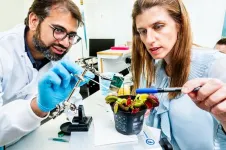(Press-News.org) Key Takeaways
Researchers have discovered that the NLRP11 protein plays critical roles in alerting the body to a bacterial infection and initiating an immune response against it
NLRP11 is present in humans and other primates but absent in mice
The discovery could enable the development of mouse models that are more similar to humans for bacterial infection experiments
BOSTON – A team led by researchers at Massachusetts General Hospital (MGH) has discovered a protein that plays critical roles in alerting the body to a bacterial infection and initiating an effective immune response to fight back against the invasion.
They found that when certain bacteria are ingested by human immune cells, the protein, called NLRP11, can recognize these bacteria through a portion of their outer coat, filling a previous gap in this recognition pathway.
NLRP11 is present in humans but not in mice, which are the most common laboratory model for human infection. The group’s discovery, which is published in Science Immunology, may therefore help investigators develop improved “humanized” mouse models of infections and diseases involving the immune system.
For the study, the researchers focused on macrophages, which are immune cells that ingest and degrade microorganisms (such as bacteria) and stimulate the action of other immune cells.
A genetic screen revealed that macrophages require the NLRP11 gene to become fully activated after ingesting certain bacteria. Mechanistically, the team found that the NLRP11 protein that’s produced from the gene enables a macrophage to sense the presence of bacterial lipopolysaccharide molecules within its interior.
Upon sensing bacterial lipopolysaccharide molecules, NLRP11 triggers an inflammasome, an intracellular multimeric protein complex that turns on a pathway that activates inflammatory responses to control infection.
In this case, NLRP11 leads to activation of an enzyme called caspase-4 that is a component of this inflammasome.
These actions by NLRP11 result in an effective defense by the immune system that kills invading bacterial cells and prevents widespread infection in the body.
“NLRP11 is present in humans and other primates but absent in mice, likely explaining why it has been missed previously, as most screens looking for innate immune signaling molecules have been carried out in mice,” says senior author Marcia B. Goldberg, MD, an investigator in the Division of Infectious Diseases at MGH and a professor in the Departments of Medicine and Microbiology at Harvard Medical School. “Our results demonstrate that NLRP11 is a previously missing link and a component of the human caspase-4 inflammasome activation pathway.”
Goldberg and her colleagues are conducting even more thorough studies of NLRP11’s functions in human macrophages, and they are comparing the differences that result from the presence of NLRP11 in human macrophages and its absence in mouse macrophages. “This may enable the development of mouse macrophages (and mice) that are more similar to human macrophages (and humans) for bacterial infection experiments,” she says.
Additional co-authors include Maricarmen Rojas-Lopez, María Luisa Gil-Marqués, Vritti Kharbanda, Amanda S. Zajac, Kelly A. Miller, Thomas E. Wood, Austin C. Hachey, and Keith T. Egger.
This work was supported by Real Colegio Complutense Fellowship, Real Colegio Complutense at Harvard (MLGM), National Institutes of Health grant R01 AI081724 (MBG), National Institutes of Health grant R01 AI173030 (MBG), National Institutes of Health grant F32 AI145128 (ASZ), National Institutes of Health grant F32 AI126765 (KAM), and National Institutes of Health grant T32 AI007061 (ASZ).
About the Massachusetts General Hospital
Massachusetts General Hospital, founded in 1811, is the original and largest teaching hospital of Harvard Medical School. The Mass General Research Institute conducts the largest hospital-based research program in the nation, with annual research operations of more than $1 billion and comprises more than 9,500 researchers working across more than 30 institutes, centers and departments. In July 2022, Mass General was named #8 in the U.S. News & World Report list of "America’s Best Hospitals." MGH is a founding member of the Mass General Brigham healthcare system.
END
Scientist discover protein required for an effective immune response to invading bacteria
The NLRP11 protein is a previously missing link that could advance the study of infections.
2023-07-26
ELSE PRESS RELEASES FROM THIS DATE:
People with increased genetic risk of Alzheimer’s may lose sense of smell first
2023-07-26
MINNEAPOLIS – People who carry the gene variant associated with the strongest risk for Alzheimer’s disease may lose their ability to detect odors earlier than people who do not carry the gene variant, which may be an early sign of future memory and thinking problems, according to a study published in the July 26, 2023, online issue of Neurology®, the medical journal of the American Academy of Neurology. The gene variant associated with this increased risk of Alzheimer’s is called APOE e4.
“Testing a person’s ability to detect odors may be a useful way to predict future problems with cognition,” said study ...
RIT professor co-authors paper on new planetary formation findings
2023-07-26
Rochester Institute of Technology’s Joel Kastner, a professor in the Chester F. Carlson Center for Imaging Science and School of Physics and Astronomy, and a team of researchers with the European Southern Observatory (ESO) have discovered new evidence of how planets as massive as Jupiter can form, using images from the ESO’s Very Large Telescope (VLT) and the Atacama Large Millimeter/submillimeter Array (ALMA).
The combination of VLT and ALMA imaging have yielded detections of dusty ...
Delaying methane mitigation increases risk of breaching Paris Agreement climate goal, study finds
2023-07-26
A new study by Simon Fraser University researchers shows that efforts to reduce methane emissions are needed immediately if we are to meet global climate change goals.
A key element of the 2015 Paris Agreement, a legally binding international treaty on climate change, is the commitment to limit average global temperatures increases to well below 2°C above pre-industrial levels, and pursue efforts to limit global warming to 1.5°C above pre-industrial levels. This requires reaching net-zero CO2 emissions by or around 2050—and deep reductions in methane and other ...
Lizards may miss out on mating opportunities and pick partners more hastily under warming temperatures
2023-07-26
Lizards may miss out on mating opportunities and pick partners more hastily under warming temperatures
###
Article URL: https://journals.plos.org/plosone/article?id=10.1371/journal.pone.0285656
Article Title: Behavioural plasticity in activity and sexual interactions in a social lizard at high environmental temperatures
Author Countries: Argentina
Funding: N.R. - Student Research Grant 2019 - Animal Behavior Society https://www.animalbehaviorsociety.org/web/index.php. M. C. - Consejo Nacional ...
Fungi which normally decay wood can effectively break down low density polyethylene (LDPE) plastic instead - and do so best in the absence of wood
2023-07-26
Fungi which normally decay wood can effectively break down low density polyethylene (LDPE) plastic instead - and do so best in the absence of wood
###
Article URL: https://journals.plos.org/plosone/article?id=10.1371/journal.pone.0288133
Article Title: Wood decay fungi show enhanced biodeterioration of low-density polyethylene in the absence of wood in culture media
Author Countries: Sri Lanka
Funding: 1. RNA: TWAS research grant 18-020 RG/BIO/AS_I The world academy of science https://twas.org/ 2. RNA, PW, HH: ICGEB research grant CRP/LKA18-03 https://www.icgeb.org/ International Center for genetic engineering and biotechnology 3. RNA, HH: t(NSF/RG/2019/BT/03). http://www.nsf.ac.lk/ ...
Fast electrical signals mapped in plants with new bioelectronic technology
2023-07-26
What happens inside the carnivorous plant Venus Flytrap when it catches an insect? New technology has led to discoveries about the electrical signalling that causes the trap to snap shut. Bioelectronic technology enables advanced research into how plants react to their surroundings, and to stress.
Most people know that the nervous system in humans and other animals sends electric impulses. But do plants also have electrical signals even though they lack a nervous system? Yes, plants have electrical signals that are generated in response to touch and stress factors, such as wounds caused by herbivores and attacks on their roots. As opposed to animals, who can move out of the ...
Aphids make tropical milkweed less inviting to monarch butterflies, study finds
2023-07-26
Many gardeners will tell you that aphids are the bane of their existence. According to a new study from the University of Florida, these tiny pests also pose problems for the iconic monarch butterfly. The study found that when oleander aphids infested tropical milkweed — a nonnative milkweed species commonly used across southern portions of the U.S. stretching from California to Florida — the butterflies laid fewer eggs on the plants, and caterpillars developing on those plants were slower to mature.
Monarch butterflies depend on milkweed and its close relatives to complete their life ...
Climate change threatens 771 endangered plant and lichen species
2023-07-26
All plants and lichens listed as endangered under the Endangered Species Act are sensitive to climate change but there are few plans in place to address this threat directly, according to a new study by Amy Casandra Wrobleski of Pennsylvania State University and colleagues, published July 26, 2023 in the open-access journal PLOS Climate.
Climate change is expected to have a major impact on species around the world, especially endangered species, which are already rare. A majority of the organisms listed under the Endangered Species Act are ...
Increased step count linked to better health for people with heart failure
2023-07-26
More often, people are turning to consumer wearable devices, such as smartwatches, to monitor their health and physical activity.
Using these wearable devices, a study led by Michigan Medicine and the University of Missouri with Saint Luke’s Mid America Heart Institute finds that taking more daily steps is associated improved health, including fewer symptoms and physical limitations, for people with heart failure. The results are published in JACC: Heart Failure.
Clinicians are increasingly presented with their patients’ wearable device data, ...
NIH spent $950M for basic or applied research leading to patents providing market exclusivity for drugs approved 2010-19
2023-07-26
BENTLEY UNIVERSITY
A new study from Bentley University’s Center for Integration of Science and Industry demonstrates that the National Institutes of Health (NIH) spent $950 million on basic or applied research associated with patents that provided manufacturers with market exclusivity. This amount represents <1% (0.59%) of the $164 billion in total NIH funding for research contributing to the approval of these products.
The article in PLOS ONE titled “NIH funding for patents that contribute ...
LAST 30 PRESS RELEASES:
Making lighter work of calculating fluid and heat flow
Normalizing blood sugar can halve heart attack risk
Lowering blood sugar cuts heart attack risk in people with prediabetes
Study links genetic variants to risk of blinding eye disease in premature infants
Non-opioid ‘pain sponge’ therapy halts cartilage degeneration and relieves chronic pain
AI can pick up cultural values by mimicking how kids learn
China’s ecological redlines offer fast track to 30 x 30 global conservation goal
Invisible indoor threats: emerging household contaminants and their growing risks to human health
Adding antibody treatment to chemo boosts outcomes for children with rare cancer
Germline pathogenic variants among women without a history of breast cancer
Tanning beds triple melanoma risk, potentially causing broad DNA damage
Unique bond identified as key to viral infection speed
Indoor tanning makes youthful skin much older on a genetic level
Mouse model sheds new light on the causes and potential solutions to human GI problems linked to muscular dystrophy
The Journal of Nuclear Medicine ahead-of-print tip sheet: December 12, 2025
Smarter tools for peering into the microscopic world
Applications open for funding to conduct research in the Kinsey Institute archives
Global measure underestimates the severity of food insecurity
Child survivors of critical illness are missing out on timely follow up care
Risk-based vs annual breast cancer screening / the WISDOM randomized clinical trial
University of Toronto launches Electric Vehicle Innovation Ontario to accelerate advanced EV technologies and build Canada’s innovation advantage
Early relapse predicts poor outcomes in aggressive blood cancer
American College of Lifestyle Medicine applauds two CMS models aligned with lifestyle medicine practice and reimbursement
Clinical trial finds cannabis use not a barrier to quitting nicotine vaping
Supplemental nutrition assistance program policies and food insecurity
Switching immune cells to “night mode” could limit damage after a heart attack, study suggests
URI-based Global RIghts Project report spotlights continued troubling trends in worldwide inhumane treatment
Neutrophils are less aggressive at night, explaining why nighttime heart attacks cause less damage than daytime events
Menopausal hormone therapy may not pose breast cancer risk for women with BRCA mutations
Mobile health tool may improve quality of life for adolescent and young adult breast cancer survivors
[Press-News.org] Scientist discover protein required for an effective immune response to invading bacteriaThe NLRP11 protein is a previously missing link that could advance the study of infections.



